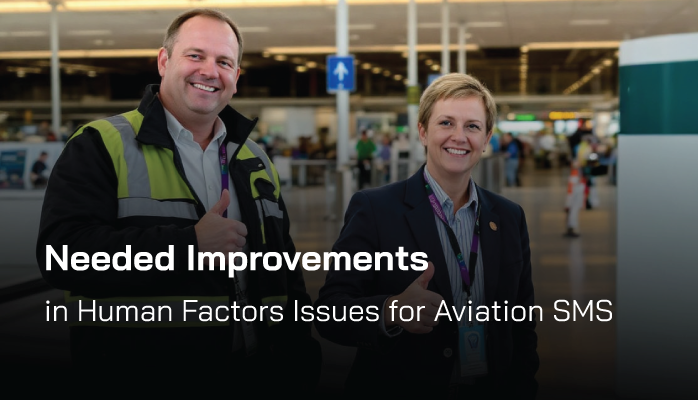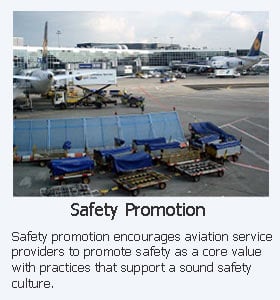Aviation SMS Encourage Safe Behavior

The FAA's requirement of many aviation service providers to create a formal aviation Safety Management System (SMS) stretches far beyond the realm of immediate safety concerns.
FAA not only recognized the value of an SMS to help keep aviation service providers safe on an ongoing basis, but to also pave the way for future improvements that can shape aviation in the long run.
SMS are designed to proactively encourage safe behavior throughout an organization. The system helps reiterate that safety starts from the top down, from the minute the plane is manufactured and sold, to when it is towed into the hangar at night.
Everyone Must Participate in Aviation SMS - Not Just Flight Crews
A thoroughly implemented SMS attempts to encourage everyone to be dedicated to safety in all aspects. SMS is designed to have all employees engaged in the safety process, and not just the personnel engaged in operational activities.
Being able to identify and mitigate as many hazards as possible is great, but being able to eliminate many hazards from forming altogether is a picturesque way of viewing aviation, and should be a goal for all participants in the industry.
Aviation SMS Much More Than Enhancing Safety Culture
Aviation SMS are doing more than just adding to the promotion of a safety culture--they are the forerunners of increasing safety all around for the future of aviation in two ways, including both
- Human factors; and
- Technology.
A Safety Management System is dedicated to
- Data collection,
- Analysis; and
- Problem-solving.
Analyzing recurring problems is what helps to solve problems everywhere today, not just in aviation. An SMS can help to isolate problem areas that threaten aviation safety and promote ways to fix them.
SMS Reduce Risk Related to Human Factors

Human factors in flight remain an area that continues to be ripe for improvement. Aviation SMS has helped solve problems rooted in the "human factor risk."
Here is a great example demonstrating how human factors and SMS interact. In the past, airline pilots never were able to have a bona fide out when they were fatigued. Unless they were sick, which they had to prove with a report, pilots had to fly through their fatigue. With the help of SMS, which constantly reported accidents due to pilot fatigue, the airlines provided an additional option for pilots to call in fatigued and submit a report. They are therefore not required to fly and can rest until they are fit to fly.
This is a great example of mitigating risk before it has even surfaced.
Related Aviation Human Factors Articles
- Let’s Talk Human Factors - Origin of Dirty Dozen
- Let’s Talk Human Factors - Lack of Communication
- Let’s Talk Human Factors: Distraction Is #4 of the Dirty Dozen
Needed Improvements in Human Factors Related Issues
Other ways to help with reducing human factors' risk in flight are to increase flight training in areas where pilots recurringly show weakness. An area I can see for improvement in human factors is resources for women who are pregnant.
In the aviation world it is almost frowned upon for women to leave work and have children. I think that if we developed a universal plan for maternity in aviation, it would both eradicate the fear of being a female pilot and having a child and encourage more women to enter the field.
We can also eliminate human factors related risks on the maintenance and ATC portions of aviation operations with genuine SMS programs. Evaluation of safety reports can show us where mistakes in maintenance are made. We can also see communication lapses that happen with ATC and petitions to change phrases or include more procedures to keep traffic separated and safe.
Aviation SMS Are Technological Advances
The area of aviation technology can also be greatly improved by earnestly implementing aviation SMS in the way that it was purposely designed. I'm not talking about merely "checking the box," which many operators seem to have tried.
Proactive safety reporting can also be used to isolate what equipment is becoming old and outdated and may need replacement and could aid in the creation of more advanced avionics. In turn, SMS can discover what is working and encourage users to increase safety standards. The first step is to identify the problem and then report it.
Future improvements in the operations of aviation service providers can only be created when we isolate a problem and set out to fix it.
Aviation SMS programs have increasingly become a vital tool in both identifying and helping to solve all safety problems across the realm of aviation. It is exciting to see these changes occur.
Related Aviation Hazard Reporting Articles
- Indicators of Good Hazard Reporting Culture
- How Aviation Safety Managers Can Improve Safety Reporting Cultures
- Essential KPIs for Poor Hazard Reporting Cultures in Aviation SMS - With Free KPI Resources
When was the last time you truly looked at your SMS program? We have seen that operators with proven SMS can backslide from Phase 4 of their SMS implementations all the way back to Phase 2.
A quick review of your SMS program can be as easy as downloading a checklist. Here is a good resource that is integrated into SMS Pro.
Are you on Phase 1? Check out where you are at in the SMS process.
Last updated December 2025.








